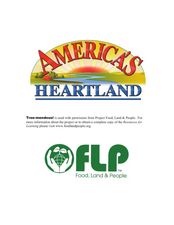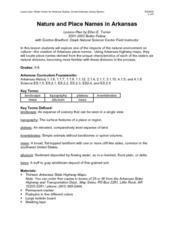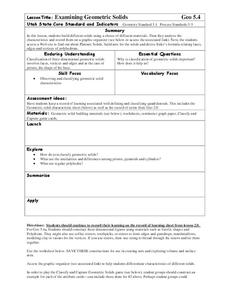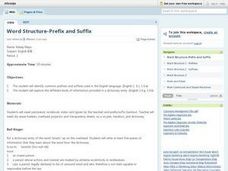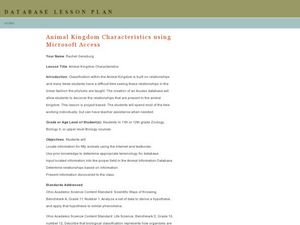Curated OER
Derivative Analysis
Students analyze the derivative of a graph. In this calculus lesson plan, students identify the different behavior of a graph. They label concavity of the graphs as increasing or decreasing.
Curated OER
Alcohols Revisited (and Ethers) and Going Further... Carboxylic Acids and Their Derivatives
Identifying characteristics of alcohols and their physical properties are reviewed in bullet-point fashion on the first two slides. The same material follows, but for ethers. Finally, the structure and naming of carboxylic acids and...
EngageNY
Populations, Samples, and Generalizing from a Sample to a Population
Determine the difference between a sample statistic and a population characteristic. Pupils learn about populations and samples in the 14th portion in a unit of 25. Individuals calculate information directly from populations called...
Howard Hughes Medical Institute
Viral Lysis and Budding
How do some viruses spread so quickly, and why do they make us feel terrible? Answer these (and many more) questions through a simple yet impactful lessons. Pupils observe demonstrations that show the two methods viruses use to escape...
Curated OER
Tree-mendous Game
Students play a game where they classify the different characteristics of trees. In this tress lesson plan, students also use tree vocabulary and describe benefits of trees.
EngageNY
Using Sample Data to Estimate a Population Characteristic
How many of the pupils at your school think selling soda would be a good idea? Show learners how to develop a study to answer questions like these! The lesson explores the meaning of a population versus a sample and how to interpret the...
EngageNY
Characteristics of Parallel Lines
Systems of parallel lines have no solution. Pupils work examples to discover that lines with the same slope and different y-intercepts are parallel. The 27th segment of 33 uses this discovery to develop a proof, and the class determines...
Curated OER
Application of Differentiation: Optimization
In this optimization worksheet, students complete a table identifying the characteristics of a function and it's derivative and provide an illustration of each type of function. Afterward, they use the first derivative test for finding...
Curated OER
Bloodstain Pattern Simulations: A Physical Analysis
Students receive bloodstain pattern evidence from a crime scene. They answer a series of questions through inquiry, observation, measurement, and analysis. Pupils complete this challenge, by reconstructing the evidence through four...
EngageNY
The Volume Formula of a Sphere
What is the relationship between a hemisphere, a cone, and a cylinder? Using Cavalieri's Principle, the class determines that the sum of the volume of a hemisphere and a cone with the same radius and height equals the volume of a...
EngageNY
Graphing the Tangent Function
Help learners discover the unique characteristics of the tangent function. Working in teams, pupils create tables of values for different intervals of the tangent function. Through teamwork, they discover the periodicity, frequency, and...
Curated OER
Nature and Place Names in Arkansas
Middle schoolers examine the way that many place names in Arkansas came to be. By looking at Arkansas highway maps, they find names that come from the characteristics of each of the state's six geographical divisions. This interesting...
Curated OER
polyhedron
Students examine the different types of polygons and their characteristics. In this polyhedrons lesson, students discuss the derivations of specific models of polyhedrons. Students work in pairs to make a copy of a polygon model, then...
Curated OER
Mammals Have Fur
First graders study animals. In this animal classification lesson, 1st graders explore the characteristics (primarily fur) that distinguish animals as mammals. They work in groups at various stations that practice this classification...
Curated OER
Examining Geometric Solids
Students explore geometry by completing a math worksheet in class. In this shape identification instructional activity, students identify the characteristics associated with 15 solid geometric shapes. Students identify patterns between...
Curated OER
Word Structure-Prefix and Suffix
Students identify the common prefixes and suffixes used in the English language. They dissect a word into its various (root, prefix, suffix) parts and use a dictionary to determine the proper usage and derivation of each word part. ...
Curated OER
WHAT, IF ANYTHING, IS A ZEBRA?
Students read the essay, "What, If Anything, Is a Zebra?" following a teacher made reading guide. They investigate cladistics, shared derived characteristics, with further online research to enhance their study of evolution and...
Curated OER
Animal Kingdom Characteristics using Microsoft Access
Students create a computer database to discover relationships present in the Animal Kingdom. In this classification lesson, students enter data into a Microsoft Access database. They answer questions on a worksheet and create a visual...
Curated OER
Sum and Difference angle formulas
Learners use the sum angle formula for sine to derive the sum and difference formulas for cosine and tangent. The level of difficulty is quite high. Learners must be familiar with trigonometric identities as well as the characteristics...
Curated OER
Mapping Where Animals Live
What type of reptiles live in New York State? This instructional activity gets the class thinking about what factors determine where particular animals live. They analyze the Hudson Valley environment, identify specific reptile and...
It's About Time
Energy from Coal
If plastic is derived from fossil fuels and fossil fuels come from dead dinosaurs, does that mean that plastic dinosaurs are made from real dinosaurs? This lesson goes into depth about coal and other fossil fuels. First the instructor...
EngageNY
The Power of Exponential Growth
How do you make a penny grow to $5,000 in just 15 days? Use the examples in this lesson to explore the concept of exponential growth and its comparison to linear models. Pupils come to understand that exponential growth eventually...
Curated OER
Floppy And the Puppies
Fifth graders reinforce and focus on the meaning derived from the text as a whole and identify and describe the main characters, events and settings in a fiction piece of writing. They incorporate a wide-range of adventurous vocabulary...
Curated OER
Identifying Vertebrates
In this biology worksheet, students look for the answers to how to classify animals. They specifically focus upon the vertebrates while differentiating the characteristics from other organisms.






